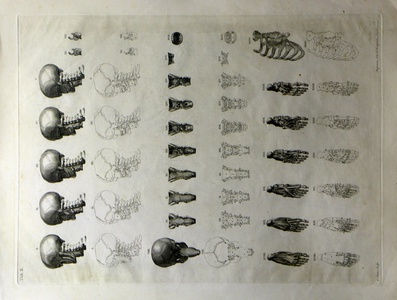| Method | Copper engraving |
| Artist | Gérard Jean Baptiste Scotin II after Jan Wandelaar |
| Published | Published by E. Cox and Son, St. Thomas Street, and No.9 Sutton Street, Southwark. 1827. |
| Dimensions | Image 380 x 540 mm, Plate 408 x 577 mm, Sheet 503 x 628 mm |
| Notes |
This plate comes from the Anatomical Tables of the Bones, Muscles, Blood Vessels, and Nerves of the Human Body. The original work, which bore the Latinate title of Tabulae sceleti et musculorum corporis humani, was published in 1747, and represented the apogee of the collaboration between an anatomist, Bernhard Siegfried Albinus, and the painter, Jan Wandalear. The work comprised forty anatomical prints, and was completed over the course of eight years. Given its fastidious methodology, scientific accuracy, and fanciful employment of pose and background, Albinus' anatomical atlas is one of the most significant physiological works ever published. Owing to this, John and Paul Knapton commissioned a series of engravers to reproduce the original works, before publishing the folio in London in 1749. E. Cox and Son reissued the plates in 1827, and they have gone on to become rare and valuable engravings in their own right. Bernhard Siegfried Albinus (1697 - 1770) was a Dutch anatomist, physician and author. He was born in Germany, where his father, Bernhardus Albinus, was the professor of medicine at the university of Frankfurt on the Oder. When Bernhardus was transferred to the chair of medicine at Leiden university, his son Bernhard, at the age of twelve, began his studies under Herman Boerhaave and Nikolaus Bidloo. In 1721, Bernhard succeeded his father in the professorship of anatomy and surgery, and speedily became one of the most famous scientific lecturers in Europe. Though his contemporary fame was base upon his pedagogic excellence, Albinus' celebrity today rests with the Tabulae sceleti et musculorum corporis humani, which was published in Leiden and largely at his own expense. Jan Wandelaar (1690 - 1759) was a Dutch draughtsman and etcher who was mainly active in Amsterdam. He was believed to have been a pupil of Johannes Jacobsz Folkema, Gilliam van der Gouwen, and Gerard de Lairesse. Wandelaar produced engravings after Jacob Houbraken, as well for Carl Linnaeus' Hortus Cliffortianus and Bernhard Siegfried Albinus' Tabulae sceleti et musculorum corporis humani. Gérard Jean Baptiste Scotin II (1698 - 1755) was a French engraver. Scotin II began his career in Paris, and engraved several works after Antoine Watteau around the year of 1725. Together with his brother, Louis Gérard, he emmigrated to London in 1733, and remained their for the entirety of his career. During this time he produced prints after Francis Hayman for Tobias Smollett's Edition of Cervantes 'Don Quixote.' He also engravinged the plates for Hogarth's 'Marriage-à-la-Mode' series in 1745. Condition: Excellent impression with full margins. |
| Framing | unmounted |
| Price | £145.00 |
| Stock ID | 30102 |

